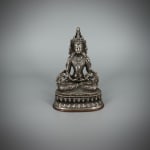Sino-Tibetan Seated Avalokiteśvara, Nineteenth to Twentieth Century AD
Silver
22 x 14 x 9 cm
8 5/8 x 5 1/2 x 3 1/2 in
8 5/8 x 5 1/2 x 3 1/2 in
GM.0062
Further images
A paradigm of the Sino-Tibetan tradition of Buddhist statuary, this resplendent silver statuette depicts the bodhisattva Avalokiteśvara, who embodies the compassion of all Buddhas. In the Buddhist faith, bodhisattvas are...
A paradigm of the Sino-Tibetan tradition of Buddhist statuary, this resplendent silver statuette depicts the bodhisattva Avalokiteśvara, who embodies the compassion of all Buddhas. In the Buddhist faith, bodhisattvas are souls who have attained enlightenment and no longer need to reincarnate, but forsake nirvana and choose to remain on earth to alleviate the suffering of others. Situated at the crossroads of present-day India, Nepal and China, the Tibetan bodhisattva incorporates elements from the different cultures while retaining a distinct Tibetan style. Conceived by Tibetan metal casters – among the finest in the world – this work embodies the style of the statuettes that is most sought-after on the market today.
This Avalokiteśvara can be identified by her five-pronged crown, which represents the five Buddhas. Behind the crown stands tall a two-tiered top-knot, or ushnisha, which creates extra brain capacity to convey the Buddha’s superlative wisdom. The bodhisattva’s face is full and rounded, which presents a degree of approachability that further affirms her status as the bodhisattva of compassion. Long drooping earlobes are kitted out with heavy earrings that represent the bodhisattva’s status as an earthly being despite having achieved enlightenment, in contrast to the historical Buddha who removed his earrings in renouncement of the physical world.
The bodhisattva has two distinct neck wrinkles, which are located above an assemblage of crystal-bead garlands. Real cavities in the garlands and decorative adornments are filled in with gilt-bronze rather than inlays. Resting on the bodhisattva’s shoulders and flowing down her arms are long strands of hair that replace a draping surplice. The hair then ends and a resting surplice detaches from the bodhisattva’s arms and gathers on the lotus flower base. Avalokiteśvara is in distinct dhyana mudra – the gesture of absolute balance, meditation, and inner peace. The hands are relaxed in the lap, and the tips of the thumbs and fingers touch each other. Seated in Dhyana asana on a double-lotus base, the hands actually rest on the soles of Avalokitesvara’s feet, while drapery bundles below them.
This Avalokiteśvara can be identified by her five-pronged crown, which represents the five Buddhas. Behind the crown stands tall a two-tiered top-knot, or ushnisha, which creates extra brain capacity to convey the Buddha’s superlative wisdom. The bodhisattva’s face is full and rounded, which presents a degree of approachability that further affirms her status as the bodhisattva of compassion. Long drooping earlobes are kitted out with heavy earrings that represent the bodhisattva’s status as an earthly being despite having achieved enlightenment, in contrast to the historical Buddha who removed his earrings in renouncement of the physical world.
The bodhisattva has two distinct neck wrinkles, which are located above an assemblage of crystal-bead garlands. Real cavities in the garlands and decorative adornments are filled in with gilt-bronze rather than inlays. Resting on the bodhisattva’s shoulders and flowing down her arms are long strands of hair that replace a draping surplice. The hair then ends and a resting surplice detaches from the bodhisattva’s arms and gathers on the lotus flower base. Avalokiteśvara is in distinct dhyana mudra – the gesture of absolute balance, meditation, and inner peace. The hands are relaxed in the lap, and the tips of the thumbs and fingers touch each other. Seated in Dhyana asana on a double-lotus base, the hands actually rest on the soles of Avalokitesvara’s feet, while drapery bundles below them.











